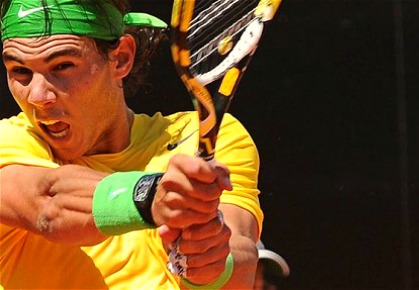 (January 1, 2013) -- It is destined to end up as the most compelling storyline in men's tennis in 2013 --already it is the most perplexing. A tragedy that is dying to become a feel-good tearjerker (just add time and clay), Rafael Nadal’s well-documented struggles with career-threatening knee injuries are currently holding us all prisoner.
(January 1, 2013) -- It is destined to end up as the most compelling storyline in men's tennis in 2013 --already it is the most perplexing. A tragedy that is dying to become a feel-good tearjerker (just add time and clay), Rafael Nadal’s well-documented struggles with career-threatening knee injuries are currently holding us all prisoner.
Short of anything but depressing news of setbacks, and the occasional clue from a canned press release, questions are all we have. Like: Will Rafa ever be Rafa again?
One thing is for certain: Love him or hate him, you miss him, and so does the game.
It’s been more than six months since Nadal's last competitive match, and while highly respected members of the media have marked this absence as significant -- comparing Nadal's period of inactivity to those experienced by former world-beaters John McEnroe and Mats Wilander -- Nadal, just 26 years of age, appears more than eager to continue nurturing his knees until he’s confident enough to give every match 100%.
But how long will the recovery take? How many more times will we be subjected to headlines of Nadal’s latest withdrawal with an accompanying photo of himgrimacing, face twisted into a disheveled querulous pout? We pulled out our hair when Delpo was unclear about his return in 2010, and we're at it again with Nadal. We just hate to see players at the prime of their careers out of commission.
The tennis blog Heavy Topspin, in a post entitled "Known Unknowns for Rafael Nadal," states that only three top 10 players have ever left the tour for six months or more and made a comeback. The blog points out that none of them -- McEnroe, Tommy Haas, or Juan Martin del Potro -- climbed as high as they were before their sabbaticals.
But this is Nadal we're talking about, a player who's taken the physicality of tennis to a level we may never see again. Nadal is too good and too unique to have his second coming compared to anybody, past or present.
What people tend to overlook about Nadal's situation are the potential benefits of a prolonged benching. Part of me has always believed that Nadal's motivation for a thorough knee repair is also driven by a desire to hop off the ATP hamster wheel. Nadal is not your typical jet-setter; He's a homebody that has probably felt conflicted living out of a suitcase since his late teens, and if he can kill two birds with one stone -- healing his body while also spending time with friends and family in Mallorca (and away from the spotlight) -- then he’s bound to benefit from it.
The absence from the tour should be good for his psyche. The return should give him a fresh perspective on life and the tour. Though Rafa's health issues are nowhere near the gravity of Serena's health scare two years ago, we all saw what that experience did to her: she came back more focused, determined, and tenacious.
But that isn't to discount the seriousness of Nadal's injury -- it did wipe out half a season, after all. But what has been overlooked all too often in our discussions and dialogue about them is the fact that Nadal and his team’s response to said injuries have been anything but alarming. How does the saying go? An ounce of prevention is worth a pound of cure. Nadal has been steadfast in acknowledging his physical limitations, and he and his team are completely active and engaged in keeping the Spaniard in tip-top shape.
Rather than panicking, Nadal and his team seem to be embarking on a second, more conservative career path. Some might see desperation or the broken-down, beaten-up remnants of a champion that was. I see the well-thought-out, highly strategic masterminding of a second phase of a career that is sure to be legendary.
Case in point: Nadal reportedly cut ties with IMG just last week, electing instead to give his family control of his commitments so that they can be managed in a more focused and productive manner. (Conversely, Novak Djokovic has signed with IMG.) Nadal's also showing a willingness to finally take charge of his playing schedule, resisting the allure of short-term financial rewards (and the penalties imposed by a tour that desperately needs him). One can imagine that these haven’t been easy decisions for a thoroughbred to make in his prime title-gobbling years, but in Nadal’s case there seems to be a healthy shift in expectations.
So before we shed a tear for the end of Nadal's career, realize that this could just be the intermission, with a second act to play out a truly transcendent career. In five years we may look back at this period of Nadal’s career -- one in which he and his team chose a unique and controversial method of managing a tennis player’s career and health -- as one of the most brilliant revivals in the history of the game.
It should be an interesting year.